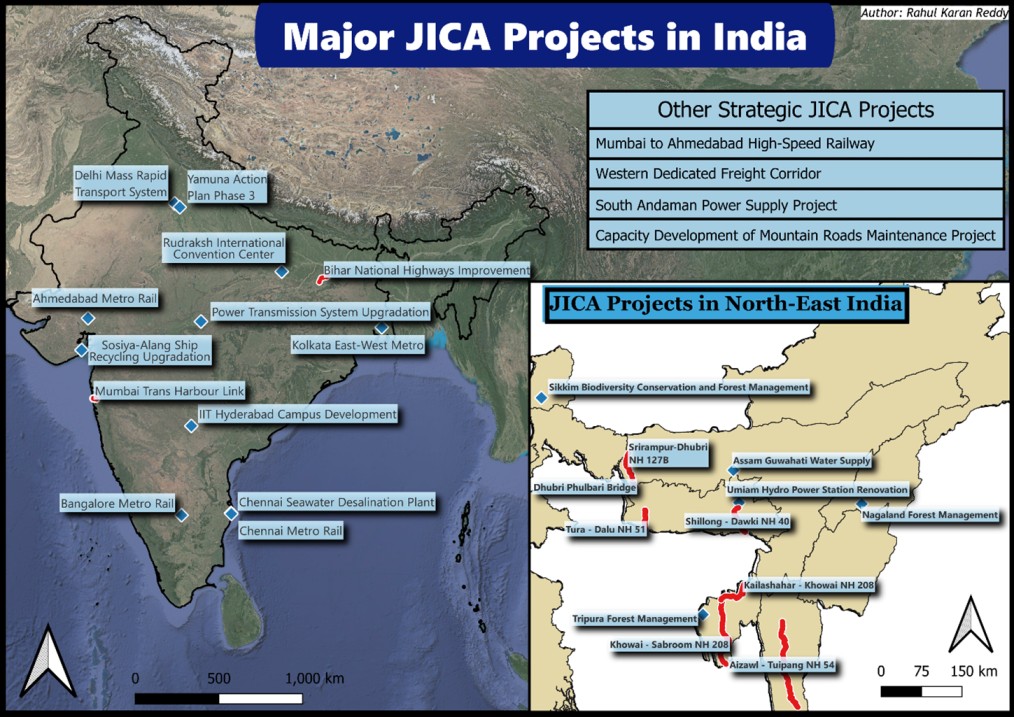This piece was originally published on Tokyo Review. Read it here.
Since Japan and India announced their intention to undertake third-country cooperation in 2020, the two countries have become closer than ever to undertaking projects in countries across the Bay of Bengal region. The foundation for third-country cooperation in South Asia had already been laid, given that India has been the largest recipient of Japan’s Overseas Development Assistance (ODA) since 2003, particularly for the road network of India’s North-East.
Yet the significance of these projects goes beyond simply connectivity, and with Beijing betting against Japan’s involvement in India’s North-East, extending development cooperation to countries across the Bay of Bengal region takes on a geopolitical significance. Such third-country cooperation in South Asia will shape competition for influence in the developing world, the balance of power along India’s border regions with China, and demonstrate the Quad’s ability to initiate flexible minilaterals providing development aid. For India, Japan’s expanding commitments are an opportunity to inject new energy into its diplomatic and institutional outreach to South and Southeast Asia.
Strategic Dimensions of Engagement
Japan’s infrastructure investments in India’s North-East are primarily driven by the development of an industrial cluster/corridor in the Bay of Bengal region that could operate as a base for Japan’s overseas manufacturing. Moreover, Japan is also keen to enhance the connectivity of the untapped markets in the region to gain an early mover advantage amidst the broader drive to reallocate supply chains. The Indian government identifies the road networks in need of improvement and invites financing from JICA for specific projects.
Beyond economics, these projects in India’s North East also bolsters New Delhi’s ability to counter China in the region. Although none of the JICA projects are along the border with China, they are focused on improving road networks in the same region, thus allowing the central government in India to focus financing border infrastructure like the Arunachal Frontier Highway. Japan’s financing augments India’s own recent efforts to build border infrastructure that matches China’s along the eastern sector of the border. Moreover, Japan has completed the Capacity Development of Mountain Roads Maintenance Project, which has enhanced India’s ability to preserve and maintain roads in the mountainous terrain of the North East. Japan is the only country that India has allowed to participate in the North East region, partly due to the instability of the region in the past. Japan is also the only country willing to undertake projects in this region in spite of pressure from China to desist from supporting India’s construction activity in the area.
Another instance of Japan’s participation in India’s strategic-military capabilities is the 15-megawatt diesel power plant to be built on the South Andaman Islands which house tri-service bases that play a major role in monitoring and countering Chinese maritime activity in the Indian Ocean region and the South China Sea. Japan’s engagement with India has been promoted at the highest levels since the civil nuclear cooperation agreement entered into force in 2017. At the latest India-Japan Defense Policy Dialogue, India and Japan agreed to expand defense cooperation to the domains of space and cyber security, adding new dimensions to their special strategic partnership. Moreover, as Japan expands the scope of its development aid to include assistance for defensive military equipment, India and Japan could find more room to expand their engagement.
Implications for Quad and Indian Foreign Policy
By proposing to undertake projects together in the Bay of Bengal region, India and Japan create the possibility of minilateral arrangements within the Quad that can address the issue of providing development finance for connectivity infrastructure in the Global South. The India-Japan third-country cooperation model could be incorporated into the Quad as a template for future initiatives undertaken by Quad member states. For India, joint efforts in the Bay of Bengal boost India’s diplomatic and institutional arrangements like BIMSTEC whose Transport Master Plan for Connectivity converges well with JICA projects in the region and provides a roadmap for the way forward.
Moreover, India’s Act East policy and gateway to South-East Asia is enhanced by deeper engagement on connectivity infrastructure with Japan. It offers India another credible avenue to counter China’s growing footprint in South Asia as well. The outcome of India-Japan cooperation model in South Asia will influence not just India and Quad’s ability to effectively counter China in South and South-East Asia, but also in Africa, where India-Japan led Asia-Africa Growth Corridor (AAGC) could present an alternative to China’s Belt and Road Initiative (BRI) on the continent.
Public Sector Infrastructure
Japan’s ODA is not just limited to projects in India’s North East. Tokyo has undertaken several high-profile projects across cities in India like Delhi, Chennai, Bangalore, and Mumbai; financing and building metro rails, power transmission systems, water management systems and other public sector infrastructure. According to Japan’s Ministry of Foreign Affairs, Japan has provided India with 3,600 billion yen as ODA loans for such projects. Going forward, public diplomacy efforts ought to emphasize Japan’s involvement in India’s public sector infrastructure as well as undertake smaller scale cultural projects that raise Japan’s public profile in India. Greater promotion of Japan’s efforts in India also highlights the sustainable and transparent approach to development financing that characterizes Japan’s involvement in the Global South, a stark contrast to China’s approach. JICA projects are carried out after extensive consultations with the public, and project feasibility and sustainability reports are publicly available as well. Highlighting these differences not just in India, but across the Indo-Pacific would position Japan as a credible provider of development finance and connectivity infrastructure in the Global South.



Author
Rahul Karan Reddy
Rahul Karan Reddy is a Senior Research Associate at Organisation for Research on China and Asia (ORCA). He works on domestic Chinese politics and trade, producing data-driven research in the form of reports, dashboards and digital media. He is the author of ‘Islands on the Rocks’, a monograph about the Senkaku/Diaoyu island dispute between China and Japan. Rahul was previously a research analyst at the Chennai Center for China Studies (C3S). He is the creator of the India-China Trade dashboard and the Chinese Provincial Development Indicators dashboard. His work has been published in The Diplomat, East Asia Forum, ISDP & Tokyo Review, among others. He can be reached via email at [email protected] and @RahulKaranRedd1 on Twitter.